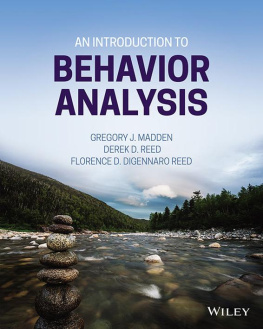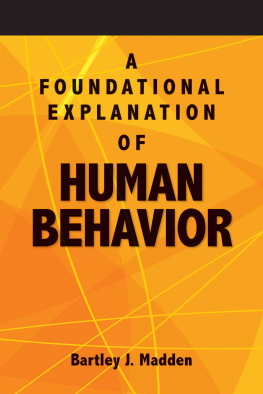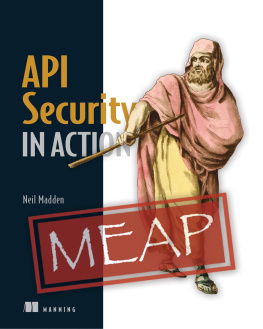Gregory J. Madden - An Introduction to Behavior Analysis
Here you can read online Gregory J. Madden - An Introduction to Behavior Analysis full text of the book (entire story) in english for free. Download pdf and epub, get meaning, cover and reviews about this ebook. year: 2021, publisher: Wiley, genre: Romance novel. Description of the work, (preface) as well as reviews are available. Best literature library LitArk.com created for fans of good reading and offers a wide selection of genres:
Romance novel
Science fiction
Adventure
Detective
Science
History
Home and family
Prose
Art
Politics
Computer
Non-fiction
Religion
Business
Children
Humor
Choose a favorite category and find really read worthwhile books. Enjoy immersion in the world of imagination, feel the emotions of the characters or learn something new for yourself, make an fascinating discovery.
- Book:An Introduction to Behavior Analysis
- Author:
- Publisher:Wiley
- Genre:
- Year:2021
- Rating:3 / 5
- Favourites:Add to favourites
- Your mark:
- 60
- 1
- 2
- 3
- 4
- 5
An Introduction to Behavior Analysis: summary, description and annotation
We offer to read an annotation, description, summary or preface (depends on what the author of the book "An Introduction to Behavior Analysis" wrote himself). If you haven't found the necessary information about the book — write in the comments, we will try to find it.
An Introduction to Behavior Analysis — read online for free the complete book (whole text) full work
Below is the text of the book, divided by pages. System saving the place of the last page read, allows you to conveniently read the book "An Introduction to Behavior Analysis" online for free, without having to search again every time where you left off. Put a bookmark, and you can go to the page where you finished reading at any time.
Font size:
Interval:
Bookmark:
GREGORY J. MADDEN
DEREK D. REED
FLORENCE D. DIGENNARO REED

This edition first published 2021
2021 John Wiley & Sons Ltd
All rights reserved. No part of this publication may be reproduced, stored in a retrieval system, or transmitted, in any form or by any means, electronic, mechanical, photocopying, recording or otherwise, except as permitted by law. Advice on how to obtain permission to reuse material from this title is available at http://www.wiley.com/go/permissions.
The right of Gregory J. Madden, Derek D. Reed and Florence D. DiGennaro Reed to be identified as the author(s) of this work has been asserted in accordance with law.
Registered Office(s)
John Wiley & Sons, Inc., 111 River Street, Hoboken, NJ 07030, USA
John Wiley & Sons Ltd, The Atrium, Southern Gate, Chichester, West Sussex, PO19 8SQ, UK
Editorial Office
The Atrium, Southern Gate, Chichester, West Sussex, PO19 8SQ, UK
For details of our global editorial offices, customer services, and more information about Wiley products visit us at www.wiley.com.
Wiley also publishes its books in a variety of electronic formats and by print-on-demand. Some content that appears in standard print versions of this book may not be available in other formats.
Limit of Liability/Disclaimer of Warranty
While the publisher and authors have used their best efforts in preparing this work, they make no representations or warranties with respect to the accuracy or completeness of the contents of this work and specifically disclaim all warranties, including without limitation any implied warranties of merchantability or fitness for a particular purpose. No warranty may be created or extended by sales representatives, written sales materials or promotional statements for this work. The fact that an organization, website, or product is referred to in this work as a citation and/or potential source of further information does not mean that the publisher and authors endorse the information or services the organization, website, or product may provide or recommendations it may make. This work is sold with the understanding that the publisher is not engaged in rendering professional services. The advice and strategies contained herein may not be suitable for your situation. You should consult with a specialist where appropriate. Further, readers should be aware that websites listed in this work may have changed or disappeared between when this work was written and when it is read. Neither the publisher nor authors shall be liable for any loss of profit or any other commercial damages, including but not limited to special, incidental, consequential, or other damages.
Library of Congress Cataloging-in-Publication Data
Names: Madden, Gregory J. (Gregory Jude), author. | Reed, Derek D., author. | DiGennaro Reed, Florence D., author.
Title: An introduction to behavior analysis / Gregory J. Madden, Derek D. Reed, Florence D. DiGennaro Reed.
Description: Hoboken, NJ : John Wiley & Sons, [2021] | Includes bibliographical references and index.
Identifiers: LCCN 2020046783 (print) | LCCN 2020046784 (ebook) | ISBN 9781119126539 (hardback) | ISBN 9781119126553 (pdf) | ISBN 9781119126546 (epub)
Subjects: LCSH: Behavioral assessment.
Classification: LCC BF176.5 .M34 2021 (print) | LCC BF176.5 (ebook) | DDC 150.28/7--dc23
LC record available at https://lccn.loc.gov/2020046783
LC ebook record available at https://lccn.loc.gov/2020046784
Cover image: Shaunl / Getty Images
Cover design by Wiley
Set in 10/12pt Minion Pro by Integra Software Services, Pondicherry, India
- Chapter 2
- Chapter 3
- Chapter 4
- Chapter 5
- Chapter 6
- Chapter 7
- Chapter 8
- Chapter 10
- Chapter 11
- Chapter 12
- Chapter 14
The course in which you are currently enrolled will give you substantive training in the behavior-analytic principles that underlie effective behavior-change interventions. For example, the principles covered in this course have proven effective in the treatment of autism spectrum disorders (Bellini & Akullian, 2007; Eldevik et al., 2009), intellectual disabilities (Heyvaert et al., 2012), antisocial behavior (McCart et al., 2006), adult anxiety and depression (st, 2008; Powers et al., 2009), and substance-use disorders (Dutra et al., 2008) to name just a few. In this class, you will learn the principles that are foundational to these successes.
Taking a more expansive view, the course will prepare you to pursue further training at one of the more than 250 universities that offer graduate degrees in behavior analysis. Should you choose to pursue this training, you would join more than 51,000 Board Certified Behavior Analysts (BCBA) who are recognized by most US states as the appropriate providers of behavior-analytic services to children and adults with disabilities. These underserved populations depend on students like you to pursue careers in the helping profession of behavior analysis.
For those not drawn to serving those with disabilities, you should know that the principles covered in this book have proven beneficial in the practice of clinical, counseling, and school psychology. For example, in 2012 the Inter-Organizational Task Force on Cognitive and Behavioral Psychology Doctoral Education outlined the most important principles that these practice-oriented psychologists must understand to be effective (Klepac et al., 2012). At least 60% of the competencies listed were behavior analytic, and many of these will be covered in this book (e.g., shaping, extinction/exposure).
Perhaps your interests lie elsewhere still. If so, you may be interested to know that the principles covered in this book have been successfully used in business settings. Indeed, some of the most effective managers are those who know how to (1) identify the behaviors of successful employees, (2) measure the occurrence and non-occurrence of those behaviors in all employees, and (3) develop behavior-management plans that encourage those successful behaviors. Managers who can do this are actually managing behavior, rather than acting like authoritarian dictators. Because behavior analysts rely on positive reinforcement in their management practices, employees tend to be happier while being more productive.
Still not interested? Well, consider that most readers of this book will one day be parents, if they are not already. Because the behavior-analytic principles covered in this book have proven so reliable in positively influencing behavior, they constitute the core of most parent-training programs; for example, the Criando con Amor, Promoviendo Armona y Superacon [Raising with Love, Promoting Harmony & Improvement] program (Baumann et al., 2014). So, if you hope to be a loving parent who helps their children to successfully navigate their world, you would do well to learn all you can from this book. Your children will never thank you for it, but you will thank yourself one day, particularly when you see other parents struggling to understand the behavior of their children.
If you are still not interested in the contents of this book, we have only one more plea consider the words of Socrates who said, The unexamined life is not worth living. Socrates was encouraging those of his age to use logic, wisdom, and philosophy in pursuit of self-knowledge, better relationships, and a harmonious existence with the natural world. These goals are timeless and universal. This book can open doors of self-discovery. So, use what you are about to learn to examine your life, your actions, your goals, your values. The examined life is even more worth living.
Font size:
Interval:
Bookmark:
Similar books «An Introduction to Behavior Analysis»
Look at similar books to An Introduction to Behavior Analysis. We have selected literature similar in name and meaning in the hope of providing readers with more options to find new, interesting, not yet read works.
Discussion, reviews of the book An Introduction to Behavior Analysis and just readers' own opinions. Leave your comments, write what you think about the work, its meaning or the main characters. Specify what exactly you liked and what you didn't like, and why you think so.













